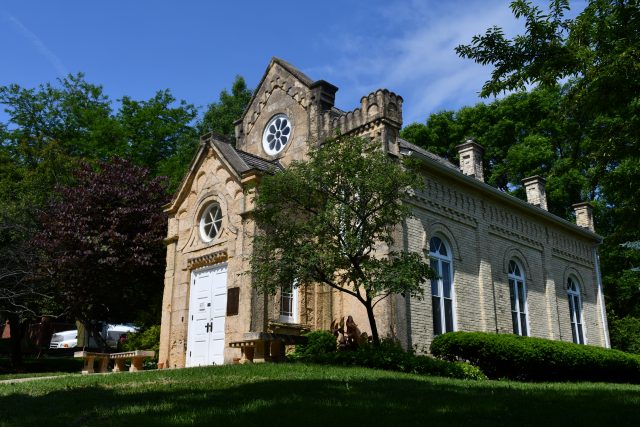 On West Washington Avenue in the fall of 1863, Madison’s first Jewish synagogue had a dedication service. The sandstone building was decorated with flowers and leaves. Congregation members filed in two by two, walking down the center isle. The building, on a lot 43 feet by 122 feet, sat 125 people. There were “quite a number of gentiles being present as curious spectators” according to the local paper. During the dedication the Rabbi, dressed in a “handsomely decorate bag of silk velvet,” congratulated the congregation on the elegance and comfort of the newly built Gates of Heaven Synagogue.
On West Washington Avenue in the fall of 1863, Madison’s first Jewish synagogue had a dedication service. The sandstone building was decorated with flowers and leaves. Congregation members filed in two by two, walking down the center isle. The building, on a lot 43 feet by 122 feet, sat 125 people. There were “quite a number of gentiles being present as curious spectators” according to the local paper. During the dedication the Rabbi, dressed in a “handsomely decorate bag of silk velvet,” congratulated the congregation on the elegance and comfort of the newly built Gates of Heaven Synagogue.
Early History
 The total cost to build the synagogue, which still stands today, was $4,000. The initial seventeen Jewish families of Madison wanted to build the “most tasteful place of worship in the city,” according to a February 16, 1863 Wisconsin State Journal article. After early renovations by the Hebrew Ladies Society at their own expense,visitors toured the building.
The total cost to build the synagogue, which still stands today, was $4,000. The initial seventeen Jewish families of Madison wanted to build the “most tasteful place of worship in the city,” according to a February 16, 1863 Wisconsin State Journal article. After early renovations by the Hebrew Ladies Society at their own expense,visitors toured the building.
“The walls, ceiling and woodwork have been artistically painted by a skillful artist,” wrote one visitor. “The ceiling is sky blue and dotted with silver stars,” according to an 1871 Wisconsin State Journal story.
The congregation, which formed in 1856, was initially active. The basement of the synagogue was dedicated to the members’ children every Saturday and Sunday. A service held in 1863 raised $23 for families of soldiers in the Madison area. There was also an occasional guest lecturer, as described here in a local newspaper advertisement.
“A literary feast is what is in store for all who avail themselves of it by going to the Jewish Synagogue this evening and listening to Rev. Mr. Simmons lecture on Dante.” The fee was 25 cents and guests were invited to stay after and “meet in a social way any who are interested in our liberal religious movement,” according to a flyer of the time.
After 1871, however, documentation on meetings became rare. The congregation shrank due to families leaving the city, increasing the synagogues’ debt with no way to pay it off. Nathan Berman, author of The German Jewish Congregation at Madison, wrote that by 1879, “the struggle was given up as futile, and the synagogue was rented out to the Unitarian Society, thus definitely and, as far as that generation or group was concerned permanently, putting an end to the existence of the reformed synagogue in Madison.”
For nearly the next 100 years the space rotated for different religious and non-religious organizations. It was rented by the Women’s Christian Temperance Union, The first Church of Christ — Scientist and The English Lutheran Church. In 1916 the congregation sold the Gates of Heaven Synagogue to a couple for $7,000. It became a funeral home, then a tearoom, then a wartime storage facility during World War II, the Church of Christ, a dental office and ultimately the office of then Congressman Robert Kastenmeier.
By the 1970s, Fiore Coal and Oil Company had purchased the land and planned to sell it for commercial development. The synagogue was to be replaced by a ten-story office building for Madison Bank and Company Trust and the Wisconsin Power and Light Company.
Saving the Synagogue
Norton Stoler, a board member at Beth El Temple, talked with the Capital Times in 1971 about the demolition with a local Rabbi some years prior.
“(The Rabbi) pointed out the forlorn synagogue building and expressed the feeling with resigned sadness that this symbol of the past might be demolished,” Mr. Stoler recalled.
Stoler and his wife, Lois, started the Gates of Heaven Synagogue Preservation Fund and had their first fundraiser, a cheese and wine night, in the fall of 1970 at a historic building in Stoughton. Their goal was an audacious one: move the more-than-100-year-old Synagogue from West Washington Avenue across the isthmus to James Madison Park on East Gorham Street and have it restored to its original appearance, at an estimated cost of nearly $60,000. They planned to raise money through bake sales, rummage sales and soliciting donations door to door. In addition, they hoped to receive a matching Historical Preservation Grant from the Housing and Urban Development commission.
In less than seven months, the preservation fund raised $15,715 in cash and more than $13,500 in donated services and materials. Money came from all over the country including New York, New Orleans and Panama City. Twelve-year-old Linda Casper of Madison gave one dollar along with a note that read: “ If we tear down the synagogue there won’t be any old buildings left for my generation to enjoy,” the Capital Times reported.
On May 28th, 1971, it was announced that HUD matching funds were granted and the preservation fund received $30,000 to move and restore the Synagogue.
“After more than a year of seesawing between the wrecker’s oblivion and historic preservation, the landmark synagogue is all but assured of survival,” Rep. Robert Kastenmeir said, as reported by the Wisconsin State Journal.
It appeared the people wanted the Synagogue to have a permanent place in Madison. It was soon discovered, however, that not everyone was on board.
In June, a City Council meeting was adjourned early, before the alders could vote on a contract with the company who was suppose to move the synagogue. The early adjournment forced the council to hold an emergency meeting. Council member George Forster, who moved for the adjournment, was accused of being an obstructionist and openly against moving the synagogue. He called it a “junk pile” and a “waste of taxpayers money.”
“If I’m a obstructionist, then all the alderman who voted with me (for adjournment) were obstructionist, too,” Forster said. He claimed to have spoken with many residents about the synagogue and “they all think it’s a pile of junk,” according to the Captial Times. The Common Council ultimately voted to approve the move, 18-1.
Then, just a week before the move was set to take place, another setback. The Sand and Gravel Company was preparing the foundation at the site on East Gorham Street when, supposedly, a Parks Commission member called the company, telling them to stop excavation because the site location had not been agreed upon.
Another emergency meeting was held, described in the Capital Times as a “a tangle of bureaucratic confusion and wounded egos brought on a wild shouting spree.” Parks Commission members said they did not approve the second location, which lay no more than 200 feet from the initially approved spot. The foundation was already dug at the second location, which was approved by the City Council.
City Attorney Edwin Conrad told the Capital Times, “At this stage, I doubt whether the commission can do much about anything,” and added, “It’s too late, gentlemen, to correct the record.”
The construction company agreed to delay demolition of the building, but went ahead excavating the entire site surrounding the synagogue, giving it the appearance of a lighthouse on top the sea. Unphased by last minute attempts to prevent the historic structure from being saved, City attorney Edwin Conrad declared that the synagogue was going to be moved even if he had to do it himself.
Despite the disruptions, on July 17th, 1971 the 200-ton stone building was delicately lowered onto a trailer with 96 aircraft wheels, cables wrapped around the perimeter supporting its walls.
“That baby is in real crumbly shape,” remarked a member of the City Building Inspection Division.
A truck pulled the trailer slowly forward, while a World War II tanker strapped to the trailer followed behind, acting as brakes. Two hundred spectators turned out to watch it move at two miles an hour, first through FairChild, then Dayton, Hamilton and finally Butler Street. The move took all day, and despite a few near disastrous accidents, was completed in the early evening. At 7:20 p.m., crewmembers popped a bottle of champagne as the Gates of Heaven rests at its final destination on East Gorham Street, where it still stands today.
Today

The Gates of Heaven Synagogue is currently owned by the Madison Parks Department and is a popular space for special events and weddings. The synagogue has hosted a celebration of the High Holidays, honoring Rosh Hashana and Yom Kippur. Judy Sidran, whose son had his bar mitzvah at the synagogue, helps organize the annual event, which is often at max capacity.

Gigi Holland, Sidran’s friend and fellow volunteer gardener, helps take care of the grounds at the Synagogue. On June 7, 2018, Holland, is picking weeds around the lilac bushes along the back path when Sidran pulls up and greets her friend. The devoted pair have been volunteering at the Synagogue for nearly 20 years together. As they walk around, replaying the buildings history out loud, they are acutely attuned to any minor repairs that need to be done: lilac bushes growing sideways rather than upward, a small crack at the bottom of the door and a tree next to the entrance with two dead branches.
One constant that has been carried through the Gates of Heaven’s history has been the dedication to the building. This year marks its 155-yar anniversary, making it the oldest synagogue in Madison.




























